
Harpa, common name the "harp snails", is a genus of large predatory sea snails, marine gastropod mollusks in the family Harpidae.

The Trochidae, common name top-snails or top-shells, are a family of various sized sea snails, marine gastropod molluscs in the subclass Vetigastropoda. This family is commonly known as the top-snails because in many species the shell resembles a toy spinning top.
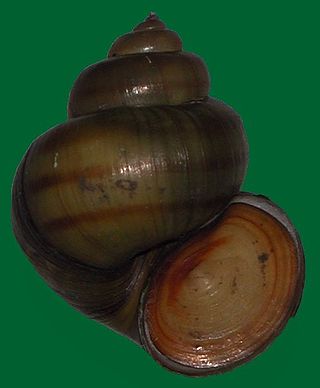
Viviparidae, sometimes known as the river snails or mystery snails, are a family of large aquatic gastropod mollusks, being some of the most widely distributed operculate freshwater snails.

Bithynia tentaculata, common names the mud bithynia or common bithynia, or faucet snail is a relatively small species of freshwater snail with gills and an operculum, an aquatic prosobranch gastropod mollusk in the family Bithyniidae.

Viviparus contectus, common name Lister's river snail, is a species of large, freshwater snail with an operculum and a gill, an aquatic gastropod mollusk in the family Viviparidae, the river snails.

Theodoxus fluviatilis, common name the river nerite, is a species of small freshwater and brackish water snail with a gill and an operculum, an aquatic gastropod mollusk in the family Neritidae, the nerites.
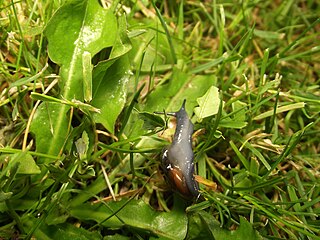
Oxychilus cellarius, common name cellar glass-snail, is a species of small air-breathing land snail, a terrestrial pulmonate gastropod mollusk in the family Oxychilidae, the glass snails.

Anisus spirorbis is a species of small freshwater air-breathing snail, an aquatic pulmonate gastropod mollusk in the family Planorbidae, the ram's horn snails.
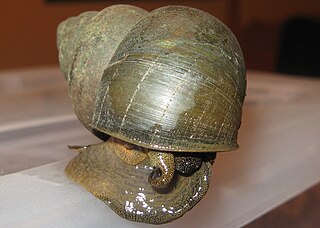
The Chinese mystery snail, black snail, or trapdoor snail, is a large freshwater snail with gills and an operculum, an aquatic gastropod mollusk in the family Viviparidae. The Japanese variety of this species is black and usually a dark green, moss-like alga covers the shell.

Mercuria similis is a species of small freshwater snail with an operculum, an aquatic gastropod mollusk in the family Hydrobiidae.

Viviparus acerosus is a species of freshwater snail with an operculum, an aquatic gastropod mollusk in the family Viviparidae, the river snails.
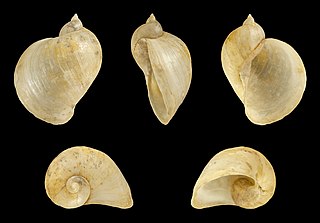
Radix auricularia, the big-ear radix, is a species of medium-sized freshwater snail, an aquatic pulmonate gastropod mollusk in the family Lymnaeidae.

Valvata piscinalis, common name the European stream valvata or European valve snail, is a species of minute freshwater snail with gills and an operculum, an aquatic gastropod mollusk in the family Valvatidae, the valve snails. It is also known as Cincinna piscinalis.
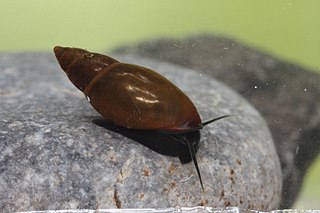
Aplexa hypnorum, or by the common name, the moss bladder snail, is a species of small air-breathing freshwater snail, an aquatic pulmonate gastropod mollusk in the family Physidae, a family which are sometimes known as the bladder snails.

Physa fontinalis, common name the common bladder snail, is a species of air-breathing freshwater snail, an aquatic gastropod mollusk in the family Physidae. The shells of species in the genus Physa are left-handed or sinistral.
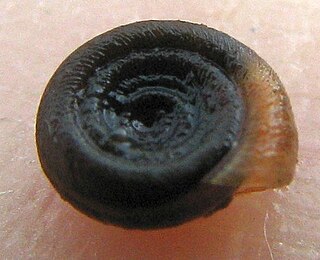
Bathyomphalus contortus is a species of small air-breathing freshwater snail, an aquatic pulmonate gastropod mollusk in the family Planorbidae, the ram's horn snails and their allies.
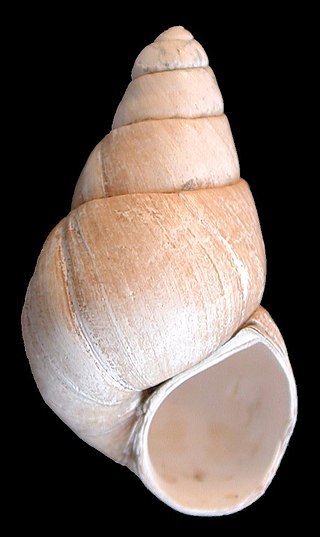
†Viviparus glacialis is an extinct species of fossil freshwater snail, an aquatic gastropod mollusks in the family Viviparidae, the river snails.

Viviparus georgianus, common name the banded mystery snail, is a species of large freshwater snail with gills and an operculum, an aquatic gastropod mollusk in the family Viviparidae, the river snails.

Pupilla muscorum, commonly known as the Moss Chrysalis snail or widespread column, is a species of minute air-breathing land snail, a terrestrial pulmonate gastropod mollusk or micromollusk in the family Pupillidae.

Filopaludina martensi is a species of large freshwater snail with a gill and an operculum, an aquatic gastropod mollusk in the family Viviparidae.























